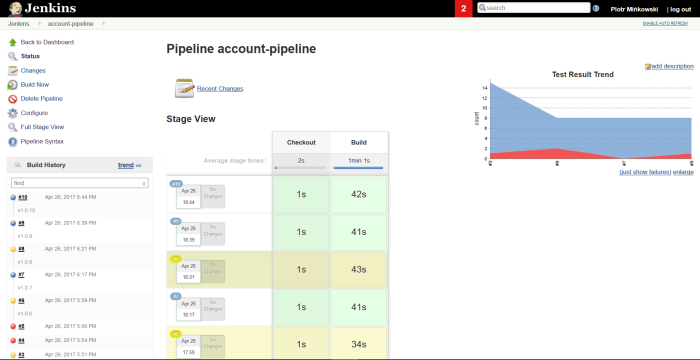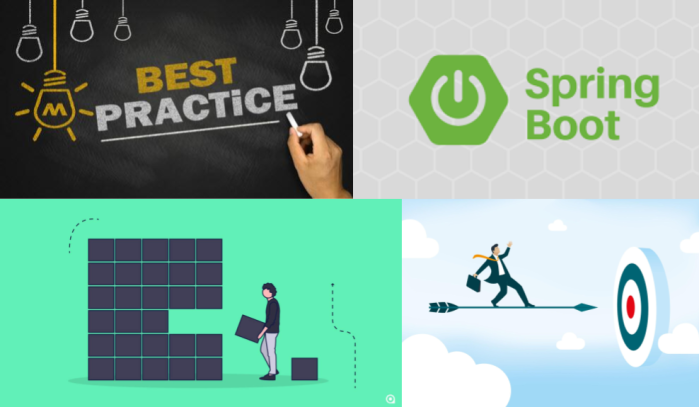In this article I’m going to propose my list of “golden rules” for building Spring Boot applications, which are a part of microservices-based system. I’m basing on my experience in migrating monolithic SOAP applications running on JEE servers into REST-based small applications built on top of Spring Boot. This list of best practices assumes you are running many microservices on the production under a huge incoming traffic. Let’s begin. Continue reading “Spring Boot Best Practices for Microservices”
Tag: Spring Cloud Contract
Continuous Integration with Jenkins, Artifactory and Spring Cloud Contract
Consumer Driven Contract (CDC) testing is one of the method that allows you to verify integration between applications within your system. The number of such interactions may be really large especially if you maintain microservices-based architecture. Assuming that every microservice is developed by different teams or sometimes even different vendors, it is important to automate the whole testing process. As usual, we can use Jenkins server for running contract tests within our Continuous Integration (CI) process.
The sample scenario has been visualized on the picture below. We have one application (person-service) that exposes API leveraged by three different applications. Each application is implementing by a different development team. Consequently, every application is stored in the separated Git repository and has dedicated pipeline in Jenkins for building, testing and deploying.
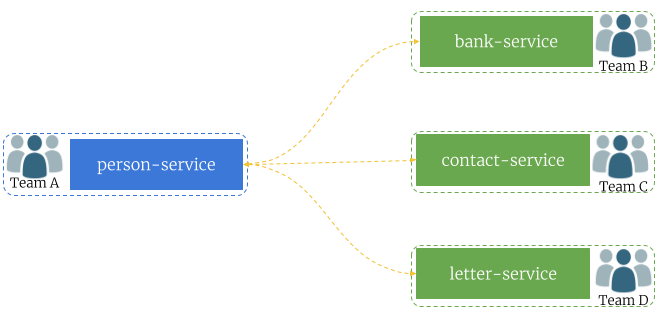
The source code of sample applications is available on GitHub in the repository sample-spring-cloud-contract-ci (https://github.com/piomin/sample-spring-cloud-contract-ci.git). I placed all the sample microservices in the single Git repository only for our demo simplification. We will still treat them as a separated microservices, developed and built independently.
In this article I used Spring Cloud Contract for CDC implementation. It is the first choice solution for JVM applications written in Spring Boot. Contracts can be defined using Groovy or YAML notation. After building on the producer side Spring Cloud Contract generate special JAR file with stubs suffix, that contains all defined contracts and JSON mappings. Such a JAR file can be build on Jenkins and then published on Artifactory. Contract consumer also use the same Artifactory server, so they can use the latest version of stubs file. Because every application expects different response from person-service, we have to define three different contracts between person-service and a target consumer.
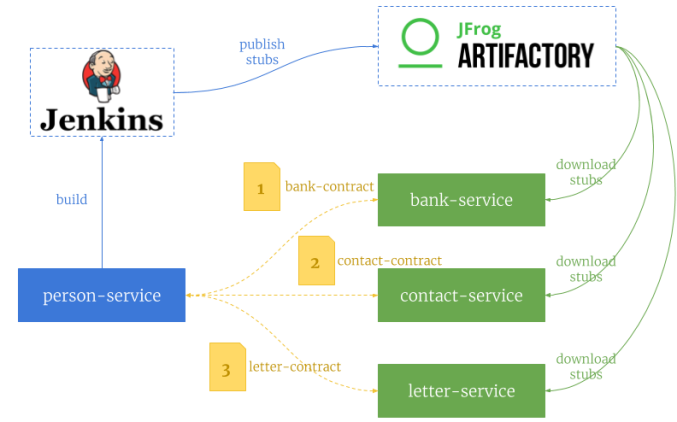
Let’s analyze the sample scenario. Assuming we have performed some changes in the API exposed by person-service and we have modified contracts on the producer side, we would like to publish them on shared server. First, we need to verify contracts against producer (1), and in case of success publish artifact with stubs to Artifactory (2). All the pipelines defined for applications that use this contract are able to trigger the build on a new version of JAR file with stubs (3). Then, the newest version contract is verifying against consumer (4). If contract testing fails, pipeline is able to notify the responsible team about this failure.
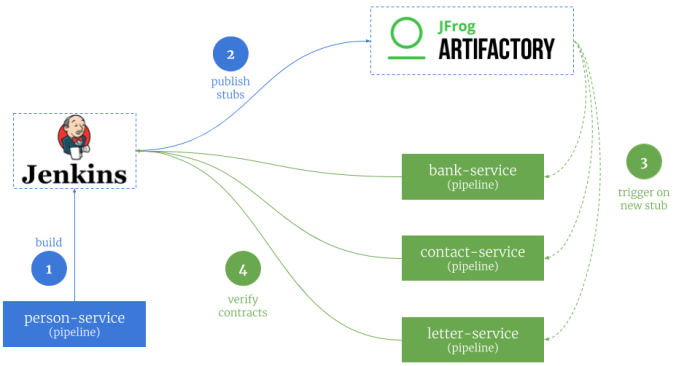
1. Pre-requirements
Before implementing and running any sample we need to prepare our environment. We need to launch Jenkins and Artifactory servers on the local machine. The most suitable way for this is through a Docker containers. Here are the commands required for run these containers.
$ docker run --name artifactory -d -p 8081:8081 docker.bintray.io/jfrog/artifactory-oss:latest $ docker run --name jenkins -d -p 8080:8080 -p 50000:50000 jenkins/jenkins:lts
I don’t know if you are familiar with such tools like Artifactory and Jenkins. But after starting them we need to configure some things. First you need to initialize Maven repositories for Artifactory. You will be prompt for that just after a first launch. It also automatically add one remote repository: JCenter Bintray (https://bintray.com/bintray/jcenter), which is enough for our build. Jenkins also comes with default set of plugins, which you can install just after first launch (Install suggested plugins). For this demo, you will also have to install plugin for integration with Artifactory (https://wiki.jenkins.io/display/JENKINS/Artifactory+Plugin). If you need more details about Jenkins and Artifactory configuration you can refer to my older article How to setup Continuous Delivery environment.
2. Building contracts
We are beginning contract definition from the producer side application. Producer exposes only one GET /persons/{id} method that returns Person object. Here are the fields contained by Person class.
public class Person {
private Integer id;
private String firstName;
private String lastName;
@JsonFormat(pattern = "yyyy-MM-dd")
private Date birthDate;
private Gender gender;
private Contact contact;
private Address address;
private String accountNo;
// ...
}
The following picture illustrates, which fields of Person object are used by consumers. As you see, some of the fields are shared between consumers, while some other are required only by single consuming application.
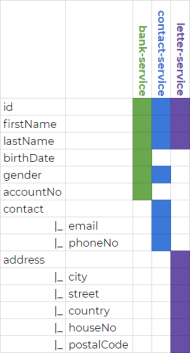
Now we can take a look on contract definition between person-service and bank-service.
import org.springframework.cloud.contract.spec.Contract
Contract.make {
request {
method 'GET'
urlPath('/persons/1')
}
response {
status OK()
body([
id: 1,
firstName: 'Piotr',
lastName: 'Minkowski',
gender: $(regex('(MALE|FEMALE)')),
contact: ([
email: $(regex(email())),
phoneNo: $(regex('[0-9]{9}$'))
])
])
headers {
contentType(applicationJson())
}
}
}
For comparison, here’s definition of contract between person-service and letter-service.
import org.springframework.cloud.contract.spec.Contract
Contract.make {
request {
method 'GET'
urlPath('/persons/1')
}
response {
status OK()
body([
id: 1,
firstName: 'Piotr',
lastName: 'Minkowski',
address: ([
city: $(regex(alphaNumeric())),
country: $(regex(alphaNumeric())),
postalCode: $(regex('[0-9]{2}-[0-9]{3}')),
houseNo: $(regex(positiveInt())),
street: $(regex(nonEmpty()))
])
])
headers {
contentType(applicationJson())
}
}
}
3. Implementing tests on the producer side
Ok, we have three different contracts assigned to the single endpoint exposed by person-service. We need to publish them in such a way to that they are easily available for consumers. In that case Spring Cloud Contract comes with a handy solution. We may define contracts with different response for the same request, and than choose the appropriate definition on the consumer side. All those contract definitions will be published within the same JAR file. Because we have three consumers we define three different contracts placed in directories bank-consumer, contact-consumer and letter-consumer.
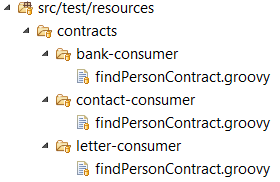
All the contracts will use a single base test class. To achieve it we need to provide a fully qualified name of that class for Spring Cloud Contract Verifier plugin in pom.xml.
<plugin> <groupId>org.springframework.cloud</groupId> <artifactId>spring-cloud-contract-maven-plugin</artifactId> <extensions>true</extensions> <configuration> <baseClassForTests>pl.piomin.services.person.BasePersonContractTest</baseClassForTests> </configuration> </plugin>
Here’s the full definition of base class for our contract tests. We will mock the repository bean with the answer matching to the rules created inside contract files.
@RunWith(SpringRunner.class)
@SpringBootTest(webEnvironment = WebEnvironment.DEFINED_PORT)
public abstract class BasePersonContractTest {
@Autowired
WebApplicationContext context;
@MockBean
PersonRepository repository;
@Before
public void setup() {
RestAssuredMockMvc.webAppContextSetup(this.context);
PersonBuilder builder = new PersonBuilder()
.withId(1)
.withFirstName("Piotr")
.withLastName("Minkowski")
.withBirthDate(new Date())
.withAccountNo("1234567890")
.withGender(Gender.MALE)
.withPhoneNo("500070935")
.withCity("Warsaw")
.withCountry("Poland")
.withHouseNo(200)
.withStreet("Al. Jerozolimskie")
.withEmail("piotr.minkowski@gmail.com")
.withPostalCode("02-660");
when(repository.findById(1)).thenReturn(builder.build());
}
}
Spring Cloud Contract Maven plugin visible above is responsible for generating stubs from contract definitions. It is executed during Maven build after running mvn clean install command. The build is performed on Jenkins CI. Jenkins pipeline is responsible for updating remote Git repository, build binaries from source code, running automated tests and finally publishing JAR file containing stubs on a remote artifact repository – Artifactory. Here’s Jenkins pipeline created for the contract producer side (person-service).
node {
withMaven(maven:'M3') {
stage('Checkout') {
git url: 'https://github.com/piomin/sample-spring-cloud-contract-ci.git', credentialsId: 'piomin-github', branch: 'master'
}
stage('Publish') {
def server = Artifactory.server 'artifactory'
def rtMaven = Artifactory.newMavenBuild()
rtMaven.tool = 'M3'
rtMaven.resolver server: server, releaseRepo: 'libs-release', snapshotRepo: 'libs-snapshot'
rtMaven.deployer server: server, releaseRepo: 'libs-release-local', snapshotRepo: 'libs-snapshot-local'
rtMaven.deployer.artifactDeploymentPatterns.addInclude("*stubs*")
def buildInfo = rtMaven.run pom: 'person-service/pom.xml', goals: 'clean install'
rtMaven.deployer.deployArtifacts buildInfo
server.publishBuildInfo buildInfo
}
}
}
We also need to include dependency spring-cloud-starter-contract-verifier to the producer app to enable Spring Cloud Contract Verifier.
<dependency> <groupId>org.springframework.cloud</groupId> <artifactId>spring-cloud-starter-contract-verifier</artifactId> <scope>test</scope> </dependency>
4. Implementing tests on the consumer side
To enable Spring Cloud Contract on the consumer side we need to include artifact spring-cloud-starter-contract-stub-runner to the project dependencies.
<dependency> <groupId>org.springframework.cloud</groupId> <artifactId>spring-cloud-starter-contract-stub-runner</artifactId> <scope>test</scope> </dependency>
Then, the only thing left is to build JUnit test, which verifies our contract by calling it through OpenFeign client. The configuration of that test is provided inside annotation @AutoConfigureStubRunner. We select the latest version of person-service stubs artifact by setting + in the version section of ids parameter. Because, we have multiple contracts defined inside person-service we need to choose the right for current service by setting consumer-name parameter. All the contract definitions are downloaded from Artifactory server, so we set stubsMode parameter to REMOTE. The address of Artifactory server has to be set using repositoryRoot property.
@RunWith(SpringRunner.class)
@SpringBootTest(webEnvironment = WebEnvironment.NONE)
@AutoConfigureStubRunner(ids = {"pl.piomin.services:person-service:+:stubs:8090"}, consumerName = "letter-consumer", stubsPerConsumer = true, stubsMode = StubsMode.REMOTE, repositoryRoot = "http://192.168.99.100:8081/artifactory/libs-snapshot-local")
@DirtiesContext
public class PersonConsumerContractTest {
@Autowired
private PersonClient personClient;
@Test
public void verifyPerson() {
Person p = personClient.findPersonById(1);
Assert.assertNotNull(p);
Assert.assertEquals(1, p.getId().intValue());
Assert.assertNotNull(p.getFirstName());
Assert.assertNotNull(p.getLastName());
Assert.assertNotNull(p.getAddress());
Assert.assertNotNull(p.getAddress().getCity());
Assert.assertNotNull(p.getAddress().getCountry());
Assert.assertNotNull(p.getAddress().getPostalCode());
Assert.assertNotNull(p.getAddress().getStreet());
Assert.assertNotEquals(0, p.getAddress().getHouseNo());
}
}
Here’s Feign client implementation responsible for calling endpoint exposed by person-service
@FeignClient("person-service")
public interface PersonClient {
@GetMapping("/persons/{id}")
Person findPersonById(@PathVariable("id") Integer id);
}
5. Setup of Continuous Integration process
Ok, we have already defined all the contracts required for our exercise. We have also build a pipeline responsible for building and publishing stubs with contracts on the producer side (person-service). It always publish the newest version of stubs generated from source code. Now, our goal is to launch pipelines defined for three consumer applications, each time when new stubs would be published to Artifactory server by producer pipeline.
The best solution for that would be to trigger a Jenkins build when you deploy an artifact. To achieve it we use Jenkins plugin called URLTrigger, that can be configured to watch for changes on a certain URL, in that case REST API endpoint exposed by Artifactory for selected repository path.
After installing URLTrigger plugin we have to enable it for all consumer pipelines. You can configure it to watch for changes in the returned JSON file from the Artifactory File List REST API, that is accessed via the following URI: http://192.168.99.100:8081/artifactory/api/storage/[PATH_TO_FOLDER_OR_REPO]/. The file maven-metadata.xml will change every time you deploy a new version of application to Artifactory. We can monitor the change of response’s content between the last two polls. The last field that has to be filled is Schedule. If you set it to * * * * * it will poll for a change every minute.
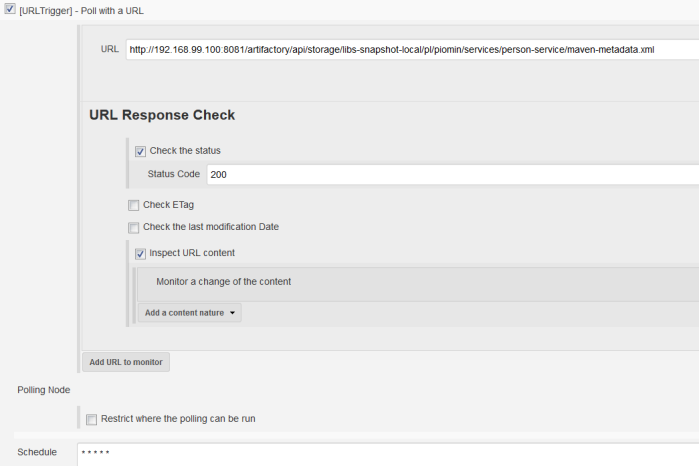
Our three pipelines for consumer applications are ready. The first run was finished with success.

If you have already build person-service application and publish stubs to Artifactory you will see the following structure in libs-snapshot-local repository. I have deployed three different versions of API exposed by person-service. Each time I publish new version of contract all the dependent pipelines are triggered to verify it.
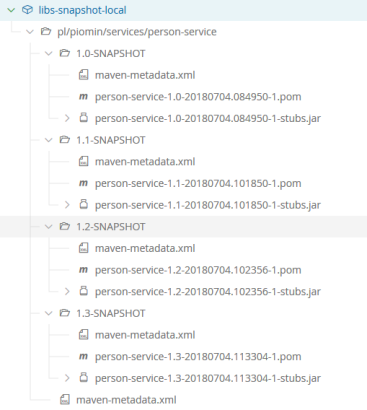
The JAR file with contracts is published under classifier stubs.
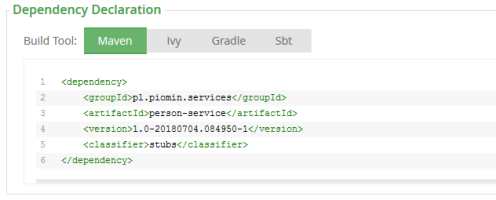
Spring Cloud Contract Stub Runner tries to find the latest version of contracts.
2018-07-04 11:46:53.273 INFO 4185 --- [ main] o.s.c.c.stubrunner.AetherStubDownloader : Desired version is [+] - will try to resolve the latest version 2018-07-04 11:46:54.752 INFO 4185 --- [ main] o.s.c.c.stubrunner.AetherStubDownloader : Resolved version is [1.3-SNAPSHOT] 2018-07-04 11:46:54.823 INFO 4185 --- [ main] o.s.c.c.stubrunner.AetherStubDownloader : Resolved artifact [pl.piomin.services:person-service:jar:stubs:1.3-SNAPSHOT] to /var/jenkins_home/.m2/repository/pl/piomin/services/person-service/1.3-SNAPSHOT/person-service-1.3-SNAPSHOT-stubs.jar
6. Testing change in contract
Ok, we have already prepared contracts and configured our CI environment. Now, let’s perform change in the API exposed by person-service. We will just change the name of one field: accountNo to accountNumber.

This changes requires a change in contract definition created on the producer side. If you modify the field name there person-service will build successfully and new version of contract will be published to Artifactory. Because all other pipelines listens for changes in the latest version of JAR files with stubs, the build will be started automatically. Microservices letter-service and contact-service do not use field accountNo, so their pipelines will not fail. Only bank-service pipeline report error in contract as shown on the picture below.

Now, if you were notified about failed verification of the newest contract version between person-service and bank-service, you can perform required change on the consumer side.
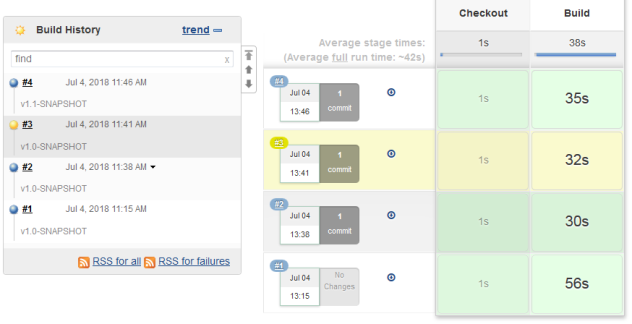
Testing REST API with Hoverfly
Hoverfly is an open source API simulation tool for automated tests. It is written in Go, but also has native support for Java and can be run inside JUnit test. Hoverfly can be used for testing REST API, but can also be useful for testing calls between microservices. We have two running modes available: simulating and capturing. In simulating mode we just simulate interaction with other service by creating response sources, in capturing mode requests will be made to the real service as normal, only they will be intercepted and recorded by Hoverfly.
In one of my previous article Testing Java Microservices I described the competitive tool for testing – Spring Cloud Contract. In the article about Hoverfly I will use the same sample application based on Spring Boot, which I created for the needs of that previous article. Source code is available on GitHub in hoverfly branch. We have some microservices which interact between each other and basing on this sample I’m going to show how to use Hoverfly for component testing.
To enable testing with Hoverfly we have to include the following dependency in pom.xml file.
<dependency> <groupId>io.specto</groupId> <artifactId>hoverfly-java</artifactId> <version>0.8.0</version> <scope>test</scope> </dependency>
Hoverfly can be easily integrated with JUnit. We can orchestrate it using JUnit @ClassRule. Like I mentioned before we can switch between two different modes. In the code fragment below I decided two use mixed strategy inCaptureOrSimulationMode, where Hoverfly Rule is started in capture mode if the simulation file does not exist and in simulate mode if the file does exist. The default location of output JSON file is src/test/resources/hoverfly. By calling printSimulationData on HoverflyRule we are printing all simulation data on the console.
@RunWith(SpringRunner.class)
@SpringBootTest(classes = { Application.class }, webEnvironment = WebEnvironment.DEFINED_PORT)
@FixMethodOrder(MethodSorters.NAME_ASCENDING)
public class AccountApiFullTest {
protected Logger logger = Logger.getLogger(AccountApiFullTest.class.getName());
@Autowired
TestRestTemplate template;
@ClassRule
public static HoverflyRule hoverflyRule = HoverflyRule
.inCaptureOrSimulationMode("account.json", HoverflyConfig.configs().proxyLocalHost()).printSimulationData();
@Test
public void addAccountTest() {
Account a = new Account("1234567890", 1000, "1");
ResponseEntity<Account> r = template.postForEntity("/accounts", a, Account.class);
Assert.assertNotNull(r.getBody().getId());
logger.info("New account: " + r.getBody().getId());
}
@Test
public void findAccountByNumberTest() {
Account a = template.getForObject("/accounts/number/{number}", Account.class, "1234567890");
Assert.assertNotNull(a);
logger.info("Found account: " + a.getId());
}
@Test
public void findAccountByCustomerTest() {
Account[] a = template.getForObject("/accounts/customer/{customer}", Account[].class, "1");
Assert.assertTrue(a.length > 0);
logger.info("Found accounts: " + a);
}
}
Now, let’s run our JUnit test class twice. During first attempt all requests are forwarded to the Spring @RestController which connects to embedded Mongo database. At the same time all requests and responses are recorded by Hoverfly and saved in the account.json file. This file fragment is visible below. During the second attempt all data is loaded from source file, there is no interaction with AccountController.
"request" : {
"path" : {
"exactMatch" : "/accounts/number/1234567890"
},
"method" : {
"exactMatch" : "GET"
},
"destination" : {
"exactMatch" : "localhost:2222"
},
"scheme" : {
"exactMatch" : "http"
},
"query" : {
"exactMatch" : ""
},
"body" : {
"exactMatch" : ""
}
},
"response" : {
"status" : 200,
"body" : "{\"id\":\"5980642bc96045216447023b\",\"number\":\"1234567890\",\"balance\":1000,\"customerId\":\"1\"}",
"encodedBody" : false,
"templated" : false,
"headers" : {
"Content-Type" : [ "application/json;charset=UTF-8" ],
"Date" : [ "Tue, 01 Aug 2017 11:21:15 GMT" ],
"Hoverfly" : [ "Was-Here" ]
}
}
Now, let’s take a look on customer-service tests. Inside GET /customer/{id} we are invoking method GET /accounts/customer/{customerId} from account-service. This method is simulating by Hoverfly with success response as you can see below.
@RunWith(SpringRunner.class)
@SpringBootTest(webEnvironment = WebEnvironment.DEFINED_PORT)
@FixMethodOrder(MethodSorters.NAME_ASCENDING)
public class CustomerControllerTest {
@Autowired
TestRestTemplate template;
@ClassRule
public static HoverflyRule hoverflyRule = HoverflyRule
.inSimulationMode(dsl(service("account-service:2222").get(startsWith("/accounts/customer/"))
.willReturn(success("[{\"id\":\"1\",\"number\":\"1234567890\"}]", "application/json"))))
.printSimulationData();
@Test
public void addCustomerTest() {
Customer c = new Customer("1234567890", "Jan Testowy", CustomerType.INDIVIDUAL);
c = template.postForObject("/customers", c, Customer.class);
}
@Test
public void findCustomerWithAccounts() {
Customer c = template.getForObject("/customers/pesel/{pesel}", Customer.class, "1234567890");
Customer cc = template.getForObject("/customers/{id}", Customer.class, c.getId());
Assert.assertTrue(cc.getAccounts().size() > 0);
}
}
To run this test successfully we should override some properties from application.yml in src/test/resources/application.yml. Eureka discovery from Ribbon client should be disabled and the same for Hystrix in @FeignClient. Ribbon listOfServers property should has same value as service address inside HoverflyRule.
eureka:
client:
enabled: false
ribbon:
eureka:
enable: false
listOfServers: account-service:2222
feign:
hystrix:
enabled: false
Here’s @FeignClient implementation for invoking API method from account-service.
@FeignClient("account-service")
public interface AccountClient {
@RequestMapping(method = RequestMethod.GET, value = "/accounts/customer/{customerId}", consumes = {MediaType.APPLICATION_JSON_VALUE})
List<Account> getAccounts(@PathVariable("customerId") String customerId);
}
When using simulation mode there is no need to start @SpringBootTest. Hoverfly has also some interesting capabilities like response templating, for example basing on path parameter, like in the fragment below.
public class AccountApiTest {
TestRestTemplate template = new TestRestTemplate();
@ClassRule
public static HoverflyRule hoverflyRule = HoverflyRule.inSimulationMode(dsl(service("http://account-service")
.post("/accounts").anyBody().willReturn(success("{\"id\":\"1\"}", "application/json"))
.get(startsWith("/accounts/")).willReturn(success("{\"id\":\"{{Request.Path.[1]}}\",\"number\":\"123456789\"}", "application/json"))));
@Test
public void addAccountTest() {
Account a = new Account("1234567890", 1000, "1");
ResponseEntity<Account> r = template.postForEntity("http://account-service/accounts", a, Account.class);
System.out.println(r.getBody().getId());
}
@Test
public void findAccountByIdTest() {
Account a = template.getForObject("http://account-service/accounts/{id}", Account.class, new Random().nextInt(10));
Assert.assertNotNull(a.getId());
}
}
We can simulate fixed method delay using DSL. Delay be set for all requests or for a particular HTTP method. Our delayed @ClassRule for CustomerControllerTest will now look like in the fragment below.
@ClassRule
public static HoverflyRule hoverflyRule = HoverflyRule
.inSimulationMode(dsl(service("account-service:2222").andDelay(3000, TimeUnit.MILLISECONDS).forMethod("GET").get(startsWith("/accounts/customer/"))
.willReturn(success("[{\"id\":\"1\",\"number\":\"1234567890\"}]", "application/json"))));
And now you can add ReadTimeout property into your Ribbon client configuration and run JUnit test again. You should receive the follwoing exception: java.net.SocketTimeoutException: Read timed out
ribbon:
eureka:
enable: false
ReadTimeout: 1000
listOfServers: account-service:2222
Conclusion
In the post I showed you the most typical usage of Hoverfly library in microservices tests. However, this library is not dedicated to microservice testing as opposed to the Spring Cloud Contract previously described by me. For example, there is no mechanisms for sharing test stubs between different microservices like in Spring Cloud Contract (@AutoConfigureStubRunner). But there is an interesting feature for delaying responses thanks to which we can simulate some timeouts for Ribbon client or Hystrix fallback.
Testing Java Microservices
While developing a new application we should never forget about testing. This term seems to be particularly important when working with microservices. Microservices testing requires different approach than tests designing for monolithic applications. As far as monolithic testing is concerned, the main focus is put on unit testing and also in most cases integration tests with the database layer. In the case of microservices, the most important test seems to be interactions between those microservices. Although every microservice is independently developed and released the change in one of them can affect on all which are interacting with that service. Interaction between them is realized by messages. Usually these are messages send via REST or AMQP protocols.
We can divide five different layers of microservices tests. The first three of them are same as for monolith applications.
Unit tests – we are testing the smallest pieces of code, for example single method or component and mocking every call of other methods or components. There are many popular frameworks that supporting unit tests in java like JUnit, TestNG and Mockito for mocking. The main task of this type of testing is to confirm that the implementation meets the requirements.
Integration tests – we are testing interaction and communication between components basing on their interfaces with external services mocked out.
End-to-end test – also known as functional tests. The main goal of that tests is to verify if the system meets the external requirements. It means that we should design test scenarios which test all the microservices take a part in that process.
Contract tests – test at the boundary of an external service verifying that it meets the contract expected by a consuming service
Component tests – limits the scope of the exercised software to a portion of the system under test, manipulating the system through internal code interfaces and using test doubles to isolate the code under test from other components.
In the figure below we can see the component diagram of the one sample microservice (customer service). That architecture is similar for all other sample microservices described in that post. Customer service is interacting with Mongo database and storing there all customers. Mapped between object and database is realized by Spring Data @Document. We also use @Repository component as a DAO for Customer entity. Communication with other microservices is realized by @Feign REST client. Customer service collects all customer’s accounts and products from external microservices. @Repository and @Feign clients are injected into the @Controller which is exposed outside via REST resource.
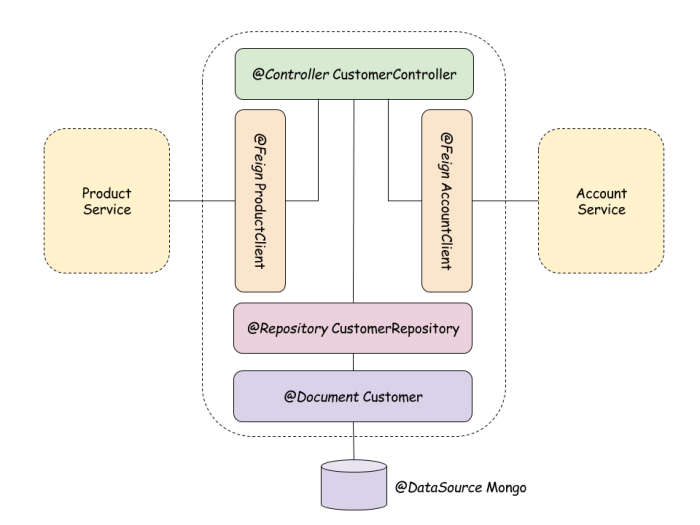
In this article I’ll show you contract and component tests for sample microservices architecture. In the figure below you can see test strategy for architecture showed in previous picture. For our tests we use embedded in-memory Mongo database and RESTful stubs generated with Spring Cloud Contract framework.
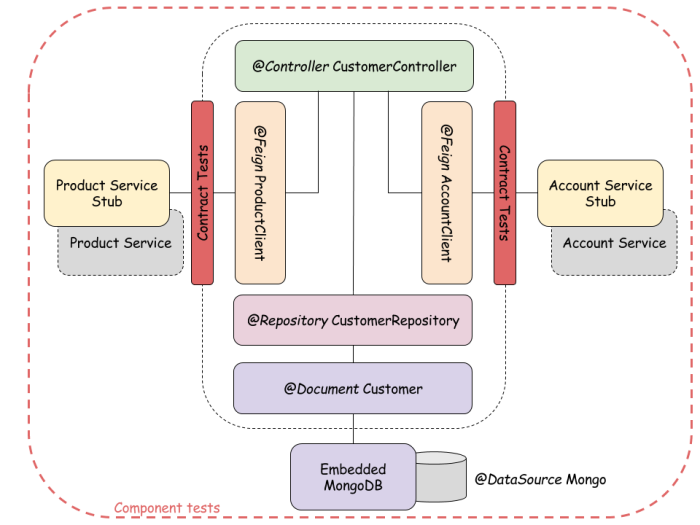
Now, let’s take a look on the big picture. We have four microservices interacting with each other like we see in the figure below. Spring Cloud Contract uses WireMock in the backgroud for recording and matching requests and responses. For testing purposes Eureka discovering on all microservices needs to be disabled.

Sample application source code is available on GitHub. All microservices are basing on Spring Boot and Spring Cloud (Eureka, Zuul, Feign, Ribbon) frameworks. Interaction with Mongo database is realized with Spring Data MongoDB (spring-boot-starter-data-mongodb dependency in pom.xml) library. DAO is really simple. It extends MongoRepository CRUD component. @Repository and @Feign clients are injected into CustomerController.
public interface CustomerRepository extends MongoRepository<Customer, String> {
public Customer findByPesel(String pesel);
public Customer findById(String id);
}
Here’s full controller code.
@RestController
public class CustomerController {
@Autowired
private AccountClient accountClient;
@Autowired
private ProductClient productClient;
@Autowired
CustomerRepository repository;
protected Logger logger = Logger.getLogger(CustomerController.class.getName());
@RequestMapping(value = "/customers/pesel/{pesel}", method = RequestMethod.GET)
public Customer findByPesel(@PathVariable("pesel") String pesel) {
logger.info(String.format("Customer.findByPesel(%s)", pesel));
return repository.findByPesel(pesel);
}
@RequestMapping(value = "/customers", method = RequestMethod.GET)
public List<Customer> findAll() {
logger.info("Customer.findAll()");
return repository.findAll();
}
@RequestMapping(value = "/customers/{id}", method = RequestMethod.GET)
public Customer findById(@PathVariable("id") String id) {
logger.info(String.format("Customer.findById(%s)", id));
Customer customer = repository.findById(id);
List<Account> accounts = accountClient.getAccounts(id);
logger.info(String.format("Customer.findById(): %s", accounts));
customer.setAccounts(accounts);
return customer;
}
@RequestMapping(value = "/customers/withProducts/{id}", method = RequestMethod.GET)
public Customer findWithProductsById(@PathVariable("id") String id) {
logger.info(String.format("Customer.findWithProductsById(%s)", id));
Customer customer = repository.findById(id);
List<Product> products = productClient.getProducts(id);
logger.info(String.format("Customer.findWithProductsById(): %s", products));
customer.setProducts(products);
return customer;
}
@RequestMapping(value = "/customers", method = RequestMethod.POST)
public Customer add(@RequestBody Customer customer) {
logger.info(String.format("Customer.add(%s)", customer));
return repository.save(customer);
}
@RequestMapping(value = "/customers", method = RequestMethod.PUT)
public Customer update(@RequestBody Customer customer) {
logger.info(String.format("Customer.update(%s)", customer));
return repository.save(customer);
}
}
To replace external Mongo database with embedded in-memory instance during automated tests we only have to add following dependency to pom.xml.
<dependency> <groupId>de.flapdoodle.embed</groupId> <artifactId>de.flapdoodle.embed.mongo</artifactId> <scope>test</scope> </dependency>
If we using different addresses and connection credentials also application seetings should be overriden in src/test/resources. Here’s application.yml file for testing. In the bottom there is a configuration for disabling Eureka discovering.
server:
port: ${PORT:3333}
spring:
application:
name: customer-service
data:
mongodb:
host: localhost
port: 27017
logging:
level:
org.springframework.cloud.contract: TRACE
eureka:
client:
enabled: false
In-memory MongoDB instance is started automatically during Spring Boot JUnit test. The next step is to add Spring Cloud Contract dependencies.
<dependency> <groupId>org.springframework.cloud</groupId> <artifactId>spring-cloud-starter-contract-stub-runner</artifactId> <scope>test</scope> </dependency> <dependency> <groupId>org.springframework.cloud</groupId> <artifactId>spring-cloud-starter-contract-verifier</artifactId> <scope>test</scope> </dependency>
To enable automated tests generation by Spring Cloud Contract we also have to add following plugin into pom.xml.
<plugin> <groupId>org.springframework.cloud</groupId> <artifactId>spring-cloud-contract-maven-plugin</artifactId> <version>1.1.0.RELEASE</version> <extensions>true</extensions> <configuration> <packageWithBaseClasses>pl.piomin.microservices.advanced.customer.api</packageWithBaseClasses> </configuration> </plugin>
Property packageWithBaseClasses defines package where base classes extended by generated test classes are stored. Here’s base test class for account service tests. In our sample architecture account service is only a produces it does not consume any services.
@RunWith(SpringRunner.class)
@SpringBootTest(classes = {Application.class})
public class ApiScenario1Base {
@Autowired
private WebApplicationContext context;
@Before
public void setup() {
RestAssuredMockMvc.webAppContextSetup(context);
}
}
As opposed to the account service customer service consumes some services for collecting customer’s account and products. That’s why base test class for customer service needs to define stub artifacts data.
@RunWith(SpringRunner.class)
@SpringBootTest(classes = {Application.class})
@AutoConfigureStubRunner(ids = {"pl.piomin:account-service:+:stubs:2222"}, workOffline = true)
public class ApiScenario1Base {
@Autowired
private WebApplicationContext context;
@Before
public void setup() {
RestAssuredMockMvc.webAppContextSetup(context);
}
}
Test classes are generated on the basis of contracts defined in src/main/resources/contracts. Such contracts can be implemented using Groovy language. Here’s sample contract for adding new account.
org.springframework.cloud.contract.spec.Contract.make {
request {
method 'POST'
url '/accounts'
body([
id: "1234567890",
number: "12345678909",
balance: 1234,
customerId: "123456789"
])
headers {
contentType('application/json')
}
}
response {
status 200
body([
id: "1234567890",
number: "12345678909",
balance: 1234,
customerId: "123456789"
])
headers {
contentType('application/json')
}
}
}
Test class are generated under target/generated-test-sources catalog. Here’s generated class for the code above.
@FixMethodOrder(MethodSorters.NAME_ASCENDING)
public class Scenario1Test extends ApiScenario1Base {
@Test
public void validate_1_postAccount() throws Exception {
// given:
MockMvcRequestSpecification request = given()
.header("Content-Type", "application/json")
.body("{\"id\":\"1234567890\",\"number\":\"12345678909\",\"balance\":1234,\"customerId\":\"123456789\"}");
// when:
ResponseOptions response = given().spec(request)
.post("/accounts");
// then:
assertThat(response.statusCode()).isEqualTo(200);
assertThat(response.header("Content-Type")).matches("application/json.*");
// and:
DocumentContext parsedJson = JsonPath.parse(response.getBody().asString());
assertThatJson(parsedJson).field("id").isEqualTo("1234567890");
assertThatJson(parsedJson).field("number").isEqualTo("12345678909");
assertThatJson(parsedJson).field("balance").isEqualTo(1234);
assertThatJson(parsedJson).field("customerId").isEqualTo("123456789");
}
@Test
public void validate_2_postAccount() throws Exception {
// given:
MockMvcRequestSpecification request = given()
.header("Content-Type", "application/json")
.body("{\"id\":\"1234567891\",\"number\":\"12345678910\",\"balance\":4675,\"customerId\":\"123456780\"}");
// when:
ResponseOptions response = given().spec(request)
.post("/accounts");
// then:
assertThat(response.statusCode()).isEqualTo(200);
assertThat(response.header("Content-Type")).matches("application/json.*");
// and:
DocumentContext parsedJson = JsonPath.parse(response.getBody().asString());
assertThatJson(parsedJson).field("id").isEqualTo("1234567891");
assertThatJson(parsedJson).field("customerId").isEqualTo("123456780");
assertThatJson(parsedJson).field("number").isEqualTo("12345678910");
assertThatJson(parsedJson).field("balance").isEqualTo(4675);
}
@Test
public void validate_3_getAccounts() throws Exception {
// given:
MockMvcRequestSpecification request = given();
// when:
ResponseOptions response = given().spec(request)
.get("/accounts");
// then:
assertThat(response.statusCode()).isEqualTo(200);
assertThat(response.header("Content-Type")).matches("application/json.*");
// and:
DocumentContext parsedJson = JsonPath.parse(response.getBody().asString());
assertThatJson(parsedJson).array().contains("balance").isEqualTo(1234);
assertThatJson(parsedJson).array().contains("customerId").isEqualTo("123456789");
assertThatJson(parsedJson).array().contains("id").matches("[0-9]{10}");
assertThatJson(parsedJson).array().contains("number").isEqualTo("12345678909");
}
}
In the generated class there are three JUnit tests because I used scenario mechanisms available in Spring Cloud Contract. There are three groovy files inside scenario1 catalog like we can see in the picture below. The number in every file’s prefix defines tests order. Second scenario has only one definition file and is also used in the customer service (findById API method). Third scenario has four definition files and is used in the transfer service (execute API method).
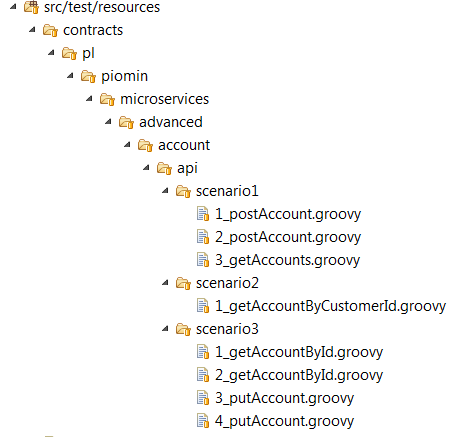
Like I mentioned before interaction between microservices is realized by @FeignClient. WireMock used by Spring Cloud Contract records request/response defined in scenario2 inside account service. Then recorded interaction is used by @FeignClient during tests instead of calling real service which is not available.
@FeignClient("account-service")
public interface AccountClient {
@RequestMapping(method = RequestMethod.GET, value = "/accounts/customer/{customerId}", consumes = {MediaType.APPLICATION_JSON_VALUE})
List<Account> getAccounts(@PathVariable("customerId") String customerId);
}
All the tests are generated and run during Maven build, for example mvn clean install command. If you are interested in more details and features of Spring Cloud Contract you can it here.
Finally, we can define Continuous Integration pipeline for our microservices. Each of them should be build independently. More about Continuous Integration / Continuous Delivery environment could be read in one of previous post How to setup Continuous Delivery environment. Here’s sample pipeline created with Jenkins Pipeline Plugin for account service. In Checkout stage we are updating our source code working for the newest version from repository. In the Build stage we are starting from checking out project version set inside pom.xml, then we build application using mvn clean install command. Finally, we are recording unit tests result using junit pipeline method. Same pipelines can be configured for all other microservices. In described sample all microservices are placed in the same Git repository with one Maven version for simplicity. But we can imagine that every microservice could be inside different repository with independent version in pom.xml. Tests will always be run with the newest version of stubs, which is set in that fragment of base test class with +: @AutoConfigureStubRunner(ids = {“pl.piomin:account-service:+:stubs:2222”}, workOffline = true)
node {
withMaven(maven: 'Maven') {
stage ('Checkout') {
git url: 'https://github.com/piomin/sample-spring-microservices-advanced.git', credentialsId: 'github-piomin', branch: 'testing'
}
stage ('Build') {
def pom = readMavenPom file: 'pom.xml'
def version = pom.version.replace("-SNAPSHOT", ".${currentBuild.number}")
env.pom_version = version
print 'Build version: ' + version
currentBuild.description = "v${version}"
dir('account-service') {
bat "mvn clean install -Dmaven.test.failure.ignore=true"
}
junit '**/target/surefire-reports/TEST-*.xml'
}
}
}
Here’s pipeline vizualization on Jenkins Management Dashboard.
